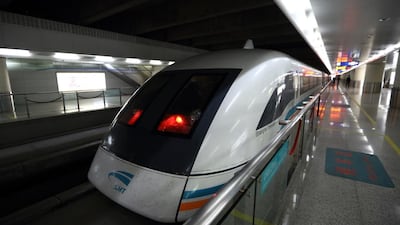TOKYO // The top operational commercial speed of the Shanghai Maglev Train, or Shanghai Transrapid, of 430kph makes it currently the world’s fastest train in regular service.
The train line, which opened in 2004, connects Shanghai Pudong International Airport and the outskirts of central Pudong where passengers can interchange to the Shanghai Metro to continue their trip to the city centre. It cost US$1.2 billion to build and was constructed by a joint venture of Siemens and ThyssenKrupp of Germany, based on years of research and development of their Transrapid maglev monorail system.
The Shanghai maglev track, or guideway, was built by local Chinese companies which, as a result of the alluvial soil conditions of the Pudong area, had to change the original track design of one supporting column every 50 metres to one with a column every 25 metres.Several thousand concrete piles were driven to depths up to 70 metres to attain the necessary stability for the support columns. A mile-long climate controlled facility was built alongside the route to manufacture the guideways. The electrification of the train was developed by the US electrical engineering firm Vahle.
The line runs from Longyang Road station in Pudong to Pudong International Airport. At full speed, the 30km journey takes 7 minutes and 20 seconds to complete, although some trains in the early morning and late afternoon take about 50 seconds longer.
The train can reach 350kph in two minutes, going on to its maximum normal operation speed of 430kph.
The Shanghai Maglev Transportation Development Company operates the line, which runs from 6:45am to 9:30pm, with services every 15 to 20 minutes. A one-way ticket costs 50 yuan (Dh26), or 40 yuan for those passengers with proof of an airline ticket purchase. A round-trip return ticket costs 80 yuan, and first-class tickets cost double the standard fare. While much trumpeted at its opening, passenger numbers average just 20 per cent of capacity.
Such low levels are attributed to limited operating hours, the short length of the line, high ticket prices and the fact that it terminates at Longyang Road in Pudong – another 20 minutes by subway from the city centre.
The South China Morning Post has reported that the train "is increasingly becoming a white elephant", while China's official Xinhua news agency reported Wang Mengshu, an academic at the Chinese Academy of Engineering and a professor at Beijing Jiaotong University's tunnel and underground engineering research centre, as saying maglev trains are nothing but "transport toys".
However, the Las Vegas-based management consulting group Global Market Advisors’ senior partner Andrew Klebanow says it is easy to label a mass transit system that fails to achieve forecast results as a white elephant, particularly if that system employs new technologies such as maglev.
While it is true that Shanghai has alternative mass transit options from the central city, subways are not as fast and do not offer the comfort and amenities found in the maglev, particularly for those commuting to the airport, he says.
“One need only try dragging a suitcase into a Shanghai subway during rush hour to appreciate the difference,” Mr Klebanov says.
The vast majority of the world’s urban mass transit systems fail to generate enough ticket revenue to cover both capital costs and operational costs but that does not make them economically unviable. Mass transit systems provide tremendous benefits to society and those costs, particularly the costs to construct those systems, must be borne by society, Mr Klebanow says.
“Imagine what New York City would be like if it did not have a mass transit system. Or Singapore. Or Hong Kong,” he says.
Such systems generate returns on investment that go far beyond repayment of construction loans, Mr Klebanow says. “They improve the quality of life in cities and allow those cities with efficient, high-speed rail systems to generate far higher levels of economic output,” he says.
Echoing that sentiment, the Ireland-based journalist Eamonn Fingleton, who has written three books on the economies of East Asian countries, says if the Shanghai maglev has been operating at a loss, it would not be the first public transit system to do so.
“From the point of view of the overall Chinese national interest over the long haul, the investment might well turn out to be an excellent one if it helps teach the Chinese how to build more maglevs to crisscross the country,” he says.
business@thenational.ae
Follow The National's Business section on Twitter

